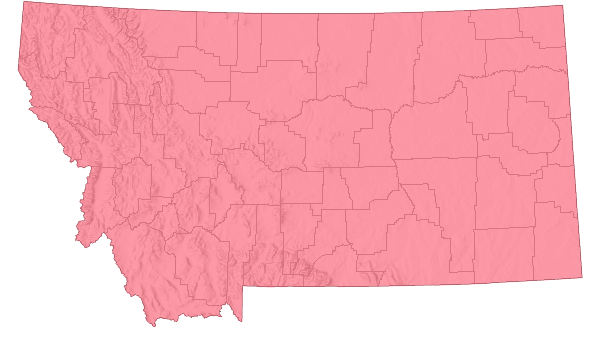View in other NatureServe Network Field Guides
NatureServe
Montana
Utah
Wyoming
Idaho
Wisconsin
British Columbia
South Carolina
Yukon
California
New York
Kingdevil Hawkweed - Hieracium praealtum
Other Names:
King Devil
State Rank Reason (see State Rank above)
Hieracium praealtum is part of the Meadow Hawkweed complex. Plants are native to Europe (FNA 2006). A conservation status rank is not applicable (SNA) because the plant is an exotic (non-native) in Montana that is not a suitable target for conservation activities.
General Description
PLANTS: Fibrous-rooted from a short rhizome, often stoloniferous. Stems erect, simple, subscapose, 30–80 cm. Herbage glabrate to sparsely long-hirsute. Source: Lesica et al. 2012.
LEAVES: Mainly basal, short-petiolate; blades oblanceolate, 3–10 cm long, entire. Source: Lesica et al. 2012.
INFLORESCENCE: Heads 10 to 30; involucres narrowly campanulate, 6–9 mm high; phyllaries scarious-margined, linear-lanceolate, sparsely stellate-hairy, stipitate-glandular, setose-hirsute. Rays 60 to 80, yellow; ligules 4–6 mm long. Achenes 1–2 mm long; pappus white. Source: Lesica et al. 2012.
Diagnostic Characteristics
Montana has about 4 native and 3 exotic Hawkweeds. Their species identification can be complex and confusing because species interbreed to form hybrids and some populations are apomictic (seed are asexually produced).
Hieracium caespitosum,
Hieracium praealtum,
Hieracium piloselloides, and
Hiercium gracile have yellow flower heads while
Hieracium aurantiacum is our only Hawkweed with red-orange flowers heads.
Kingdevil Hawkweed (
Hieracium praealtum) Villers ex Gochnat has leaves with lower surfaces that have stellate (star-shaped) hairs (FNA 2006). In Lesica’s treatment in the
Manual of Montana Vascular Plants (2012) our plants appear to better fit the description of
Hieracium praealtum Villers ex Gochnatthen than of
H. piloselloides Vill. or
H. floribundum Wimm. & Grab. However, the Strother’s treatment in the
Flora of North America (2006) does not include
Hieracium praealtum Villers ex Gochnat, but does recognize it might merit taxonomic recognition.
Meadow Hawkweed (
Hieracium caespitosum) has florets with pappus bristles in 1 series (single ring of bristles). Its upper stems and involucres have dense glandular setae (hairs), but
Hieracium praealatum has scattered glandular setae mixed in with non-glandular setae (Lesica et al. 2012).
Hieracium caespitosum has short stolons (when they are present).
Hieracium praealatum is more likely to have stolons and when present they are longer and slender.
Tall Hawkweed (
Hiercium piloselloides) has leaves (upper and lower surfaces) that are
lack both hair types of long, stiff hairs (piloso-hirsute) and stellate (star-like) hairs (FNA 2006). Leaves are glabrous or have one long, stiff hairs on the midribs and margins.
Alpine Hawkweed (
Hiercium gracile)is a native plant of the subalpine and alpine habitats. Its florets have 2 series of pappus bristles. Plants also tend to be less than 30 cm tall.
Species Range
Montana Range
Range Descriptions

 Non-native
Non-native
Range Comments
Introduced to northeast and northwest U.S. and adjacent Canada; native to Europe (Lesica et al. 2012).
For maps and other distributional information on non-native species see:
Nonindigenous Aquatic Species Database from the U.S. Geological Survey
Invasive Species Habitat Tool (INHABIT) from the U.S. Geological Survey
Invasive Species Compendium from the Centre for Agriculture and Bioscience International (CABI)
EDDMapS Species Information EDDMapS Species Information
Observations in Montana Natural Heritage Program Database
Number of Observations: 13
(Click on the following maps and charts to see full sized version)
Map Help and Descriptions
Relative Density

Recency



 (Observations spanning multiple months or years are excluded from time charts)
(Observations spanning multiple months or years are excluded from time charts)
Habitat
Roadsides, grasslands; valleys, montane (Lesica et al. 2012).
Ecology
POLLINATORS The following animal species have been reported as pollinators of this plant species or its genus where their geographic ranges overlap:
Bombus ternarius,
Bombus terricola,
Bombus bohemicus, and
Bombus flavidus (Heinrich 1976, Colla and Dumesh 2010).
Management
Stewardship Responsibility
References
- Literature Cited AboveLegend:
 View Online Publication
View Online Publication Colla, S.R. and S. Dumesh. 2010. The bumble bees of southern Ontario: notes on natural history and distribution. Journal of the Entomological Society of Ontario 141:39-68.
Colla, S.R. and S. Dumesh. 2010. The bumble bees of southern Ontario: notes on natural history and distribution. Journal of the Entomological Society of Ontario 141:39-68. Flora of North America Editorial Committee. 2006. Flora of North America North of Mexico. Vol. 19. Magnoliophyta: Asteridae, part 6: Asteraceae, part 1. Oxford Univ. Press, New York. xxiv + 579 pp.
Flora of North America Editorial Committee. 2006. Flora of North America North of Mexico. Vol. 19. Magnoliophyta: Asteridae, part 6: Asteraceae, part 1. Oxford Univ. Press, New York. xxiv + 579 pp. Lesica, P., M.T. Lavin, and P.F. Stickney. 2012. Manual of Montana Vascular Plants. Fort Worth, TX: BRIT Press. viii + 771 p.
Lesica, P., M.T. Lavin, and P.F. Stickney. 2012. Manual of Montana Vascular Plants. Fort Worth, TX: BRIT Press. viii + 771 p.
- Additional ReferencesLegend:
 View Online Publication
View Online Publication
Do you know of a citation we're missing? Lesica, P., M.T. Lavin, and P.F. Stickney. 2022. Manual of Montana Vascular Plants, Second Edition. Fort Worth, TX: BRIT Press. viii + 779 p.
Lesica, P., M.T. Lavin, and P.F. Stickney. 2022. Manual of Montana Vascular Plants, Second Edition. Fort Worth, TX: BRIT Press. viii + 779 p.
- Web Search Engines for Articles on "Kingdevil Hawkweed"





